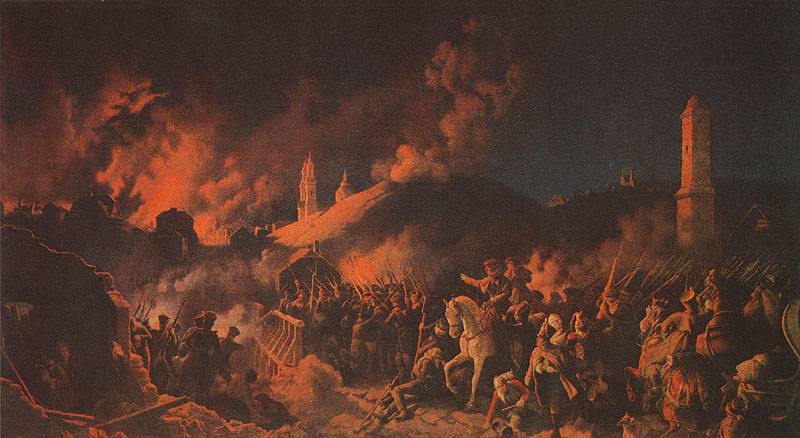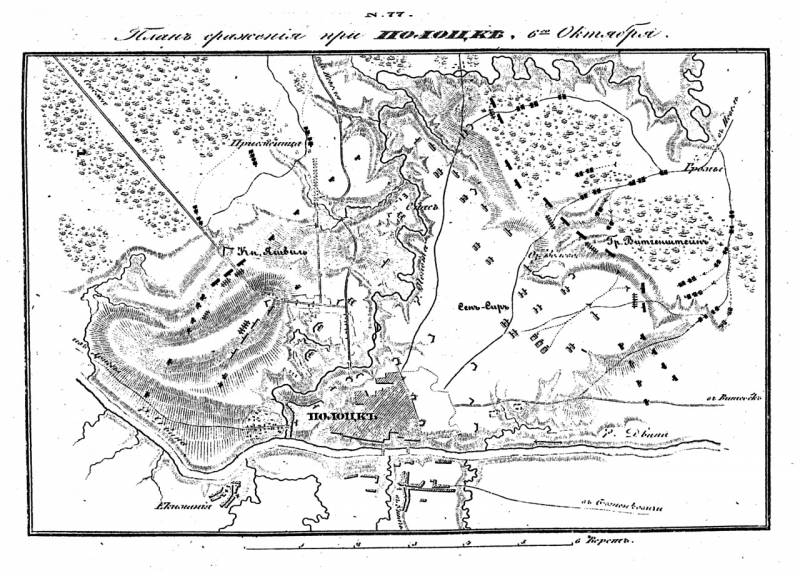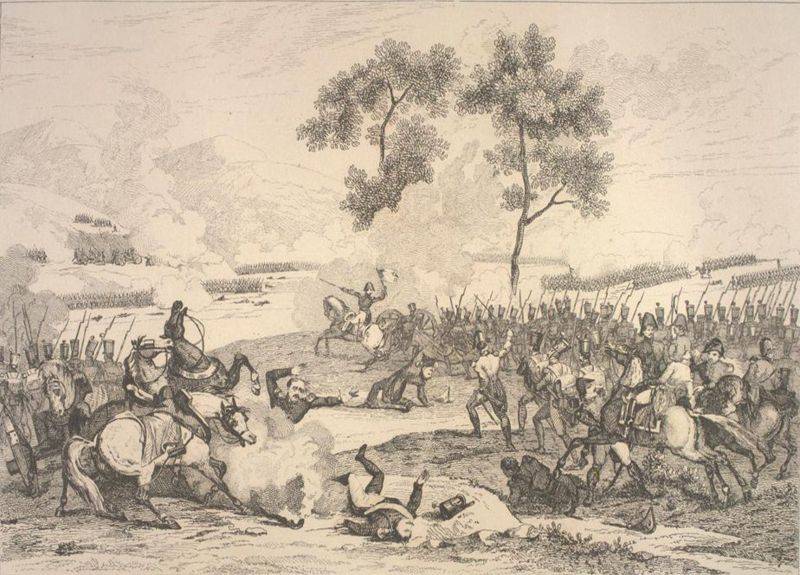The defeat of the French army in the second battle of Polotsk

Peter von Hess. Battle of Polotsk
General situation
In September 1812, Russian troops under the command of Wittgenstein were located in the Polotsk region and fettered the 2nd and 6th corps of the Great Army under the command of Saint-Cyr (Oudinot was wounded in the first battle for Polotsk). Both sides did not advance, as the forces were approximately equal.
However, the balance of power on the northern flank was gradually changing in favor of the Russian army. Russia entered into an alliance with Sweden and transferred the 10th Finnish Corps of Steingel to Riga. It was decided to transfer the Finnish Corps from Riga to reinforce Wittgenstein. By the beginning of October, Wittgenstein's corps was reinforced by 14 thousand Petersburg militia with 24 guns. Also arrived squads of the Novgorod militia. As a result, Peter Khristianovich had a whole army at hand - 50 thousand bayonets and sabers with 170 guns.
Polotsk was located on the right (northern) bank of the Western Dvina. The main forces of Saint-Cyr (the heavily depleted 2nd and 6th corps, only about 32 thousand soldiers) were based on the left (southern) bank opposite Polotsk. The French, not hoping for help, were well fortified. They covered the road to Beshenkovichi, keeping in touch with Augereau's reserve 11th Corps. The French and Bavarians (6th Corps) were unable to establish a normal supply. The outskirts of Polotsk were devastated, the Russian detachments interfered with the foragers. Supplies from Vilna were insufficient. The commander even had to send part of the horse corps beyond the Dvina, where oats and hay could still be found.
Thus, the French acted on the defensive. Field fortifications in front of the city and tete-de-pon (bridgehead), covering the bridge on rafts near the village of Struyni, three miles above the city, defended the remnants of the 6th Bavarian corps (it had only about 5 thousand soldiers) under the command of Wrede . The divisions of Legrand and Maison from the 2nd Corps stood on the left bank of the Polota River between the city and fortification No. 7. The Merle division from the 2nd Corps was located on both sides of the Petersburg road, ahead of fortifications No. .
Russian offensive
Steingel's corps was supposed to cross to the left bank of the Dvina near Pridruisk and go behind enemy lines. A second crossing was built near the Disna River to communicate with the main forces, it was guarded by the Bellingshausen detachment (two consolidated infantry regiments with 4 guns). On October 3 (15), the troops were divided into three columns, which were supposed to attack Polotsk from different directions. The attack was scheduled for 5 (17) October.
The 1st Corps under the command of Count Wittgenstein himself entered the left and central columns, the 2nd Corps under the command of Lieutenant General Yashvil entered the right column. The central column under the leadership of Lieutenant General Berg, which received the task of going from Sivoshin to Yurevichi, included the Cossack regiment of Rodionov 2nd, 16 squadrons and 18 battalions with 56 guns (a total of about 12 thousand people). The left column of Major General Begichev had the task of moving from Krasnopolye to Yurevichi, it included a hundred Cossacks, 4 squadrons, 8 battalions and 8 squads with 18 guns (9 thousand people). The right column of Yashvil had the task of advancing along the right side of the Polota River, distracting the enemy. It consisted of the Platov 4th Cossack regiment, 7 squadrons, 14 battalions and 6 squads with 68 guns (about 11 thousand people).
The offensive of the Russian troops began on October 4 (16). The main forces of the right column moved from Sivoshin to Bely. The vanguard of the middle column under the command of Balk moved from Sivoshin to Zhartsy.
The Russian offensive forced the detachment of Maison, who covered the foragers, to retreat to the city. Saint-Cyr advanced the cavalry to observe the Russians. Cuirassiers of Dumerka guarded the left bank of the river, upstream, to Beshenkovichi. The light cavalry and three Bavarian battalions under Corbino were given the task of watching the coast from Polotsk to Drissa and beyond. On the same day, all the sick and wounded were sent across the Dvina.

Battle plan of Polotsk on October 6, 1812. Source: Alexander Ivanovich Mikhailovsky-Danilevsky “Description of the Patriotic War of 1812. Part IV"
Battle
On October 5 (17), the vanguard of Balk, consisting of two regiments of chasseurs, several squadrons and 6 guns, moved to Yurevichi and attacked the enemy, who occupied the left bank of Polota. Soon the vanguard of the left column arrived under Dibich and supported Balk. Our troops pushed the enemy back to Polotsk. The enemy retreated to the city. Wittgenstein arrived with the main forces to the Yurevichi and gave the order to Balk to pursue the enemy along the left bank of the Polota. Yashvil was to push back the advance detachments of the enemy, who stood on the St. Petersburg and Riga roads. His vanguard, under the command of Vlastov, knocked out a detachment of Merle's division by 4 o'clock in the afternoon. The French counterattacked.
October 6 (18) was a stubborn battle. Our forward detachments drove the enemy's vanguard into the village of Gromy. The French retreated to the fortifications of the city. The Grodno hussars tried to develop the offensive, but were repelled by artillery fire. The French cavalry launched a counterattack, but was repulsed by the Consolidated Guards Regiment. At about 11 o'clock the French cavalry again attacked the left-flank detachment of the Russian corps. However, the situation was rectified by reserve squadrons of the Consolidated Guards, Life Dragoon, Life Hussars and Grodno Hussars, which hit the enemy on the flank and overturned him. The enemy cavalry suffered significant damage and retreated.
Russian arrows, including the soldiers of the Petersburg militia, knocked out the enemy from his advanced fortifications. Legrand threw the 26th light, 19th and 56th line regiments into a counterattack and recaptured the position. At the same time, the Russian infantry and militias captured fortification No. 9 at the Brick Factory, and Colonel Ridiger with rangers and guards pushed the enemy back beyond Volovye Lake. Marshal Saint-Cyr, who rode up to Oxen Lake to study the situation, was shot in the leg by a bullet. But the commander continued to lead his troops.
The columns of Berg and Begichev supported the attack of the center. This forced the enemy to retreat to the city itself. The French cavalry again tried to counterattack, but was repulsed by our cavalry. The French artillery fire stopped the further advance of the Russian troops. Wittgenstein was forced to pull the troops back somewhat, and about 4 hours stopped the attacks. At the forefront of the wounded Bulk was replaced by Dibich.
At the same time, on the right bank of the Polota, the troops of Yashvil pressed on the enemy. The advance detachment of Vlastov shot down the enemy on the Disna and Sebezh roads. Then our troops hit Merle's division. The French counterattacked and drove back Vlastov's vanguard. He was supported by the main forces and stopped the enemy. The hussars carried out a flank attack and cut off the 3rd Croatian regiment, which capitulated. Merle's division hastily withdrew behind the fortifications to the city. Attempts by our troops to develop the offensive were repulsed by strong artillery fire. Yashvil stopped the offensive.
Thus, the battle was stubborn and went with varying degrees of success. Saint-Cyr was able to repel the blow of the Russian army. The French quite successfully fought back in fortified positions, counterattacked. Russian superiority in forces was not realized due to a well-prepared defense, skillful actions of the enemy and poor cooperation between our troops. The terrain was difficult: swamps and forests.
Meanwhile, Steingel's troops were already 20–25 versts from Polotsk. Soon the Finnish Corps was able to attack the enemy from the left bank of the Dvina.

Battle for Polotsk. XNUMXth century drawing
French retreat
On October 7 (19), 1812, the opponents remained in their previous positions and watched each other. Saint-Cyr was waiting for reports from mounted reconnaissance on the left bank of the Dvina. Wittgenstein waited for the approach of the Finnish Corps in order to continue the battle.
At 10 o'clock, the French marshal received a report from Corbino that the Russian detachment was advancing down the left bank of the Dvina. The general asked for reinforcements. Saint-Cyr sent a detachment of General Amey (3 infantry regiments and a cuirassier) to help. At 2 o'clock Corbino's new envoy arrived and said that there were more Russians than thought and he would not last long.
The French-Bavarian troops were under threat of encirclement. The generals offered to retreat before it was too late. The marshal refused, he wanted to wait for the night. The French are lucky. Thick fog interrupted the fight. Steingel's corps stopped 4 miles from the city. Saint-Cyr ordered the withdrawal of artillery, followed by the divisions of Legrand, Maison, Merle and the remnants of the Bavarians. The French retreated exemplarily.
Noticing movement in the enemy camp, Russian artillery increased their fire. Fires started in the city. Having discovered the enemy's retreat, our troops made a series of attacks and at 2 o'clock in the morning began a general assault. Detachments of Vlastov and Ridiger broke into the burning Polotsk from two sides. Other units soon entered the city. The battle in the burning city was distinguished by great bitterness. The enemy fought back desperately.
The French commander ordered the destruction of bridges across the river. About 2 thousand Bavarian soldiers who did not have time to evacuate were blocked and surrendered. Also rich trophies, ammunition and provisions of the 2nd and 6th corps were captured in the city.
In two days of fighting near Polotsk, the French and Bavarians lost 6-7 thousand people, including more than 2 thousand prisoners. The Russian army lost up to 8 thousand killed and wounded. The city was heavily destroyed and littered with the bodies of the dead.
Steingel, fearing that all enemy forces would oppose him, retreated to the Disna and on October 9 (21) crossed to the right side of the Dvina. Wittgenstein sent Sazonov's detachment to help him. On the night of October 10-11, a bridge across the Dvina was built and Wittgenstein's troops began crossing. On the same day, Steingel joined Sazonov and crossed the river again. Wrede was defeated with the Bavarians, lost his convoy and retreated to Glubokoe.
Thus, the Russian army defeated the enemy on the northern flank, freed Polotsk and an important road. The troops of Saint-Cyr were able to avoid encirclement and complete defeat, withdrew to the Neman, where they joined up with Victor's corps.
Information